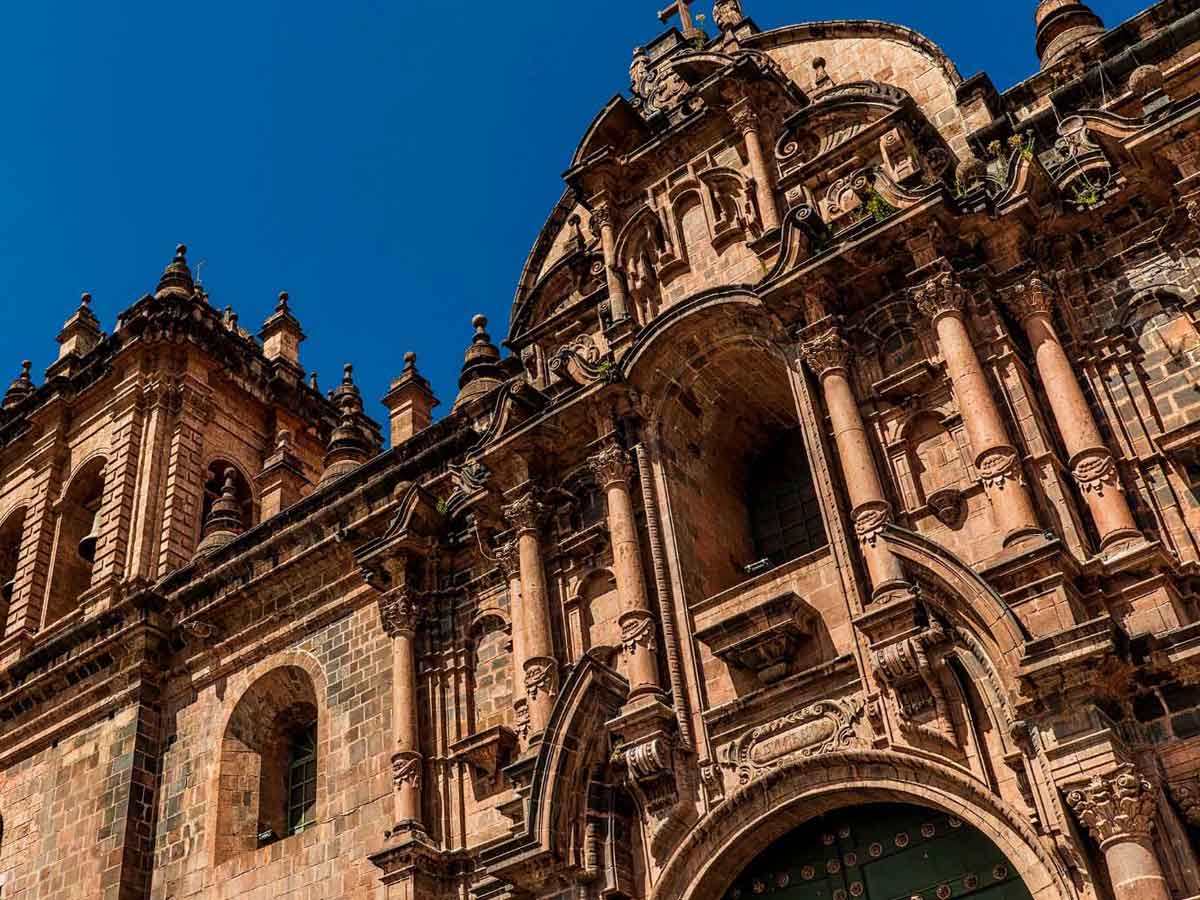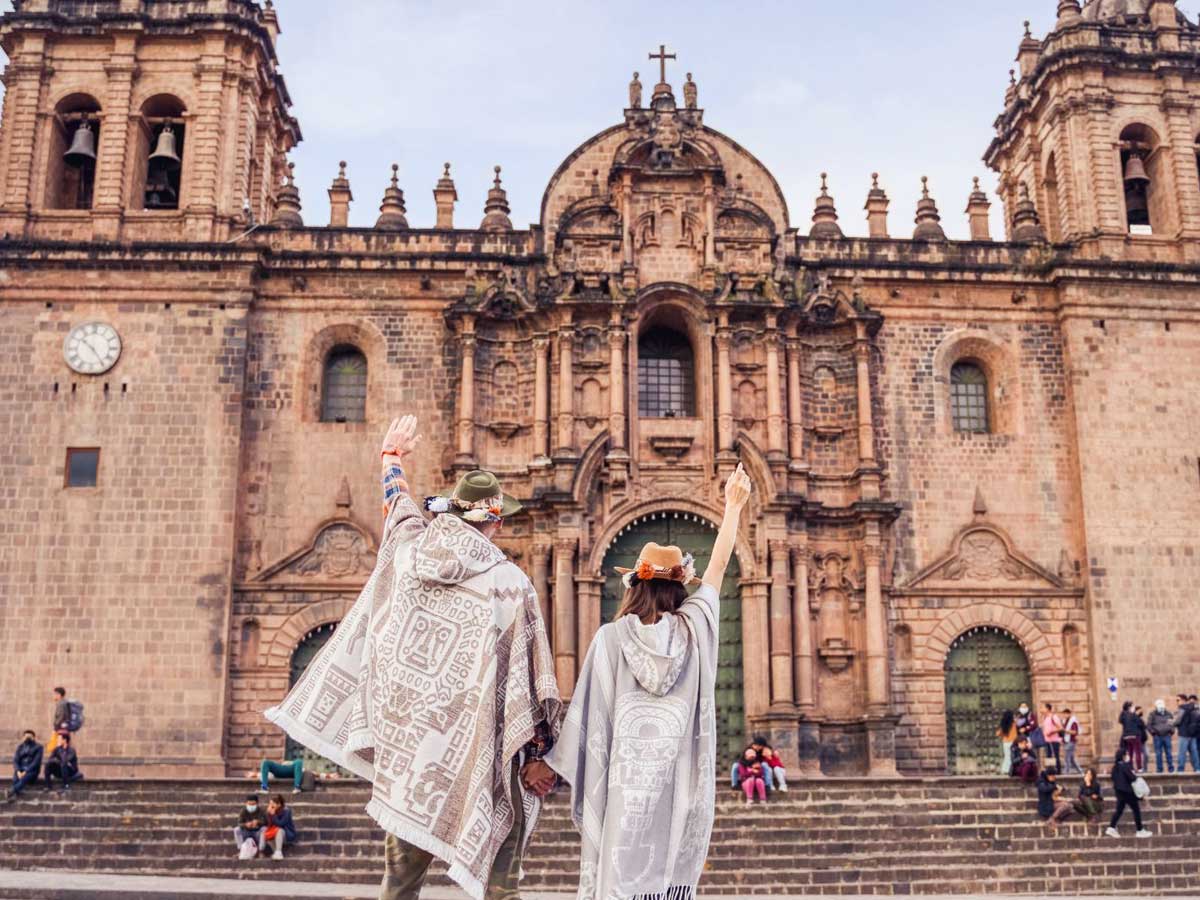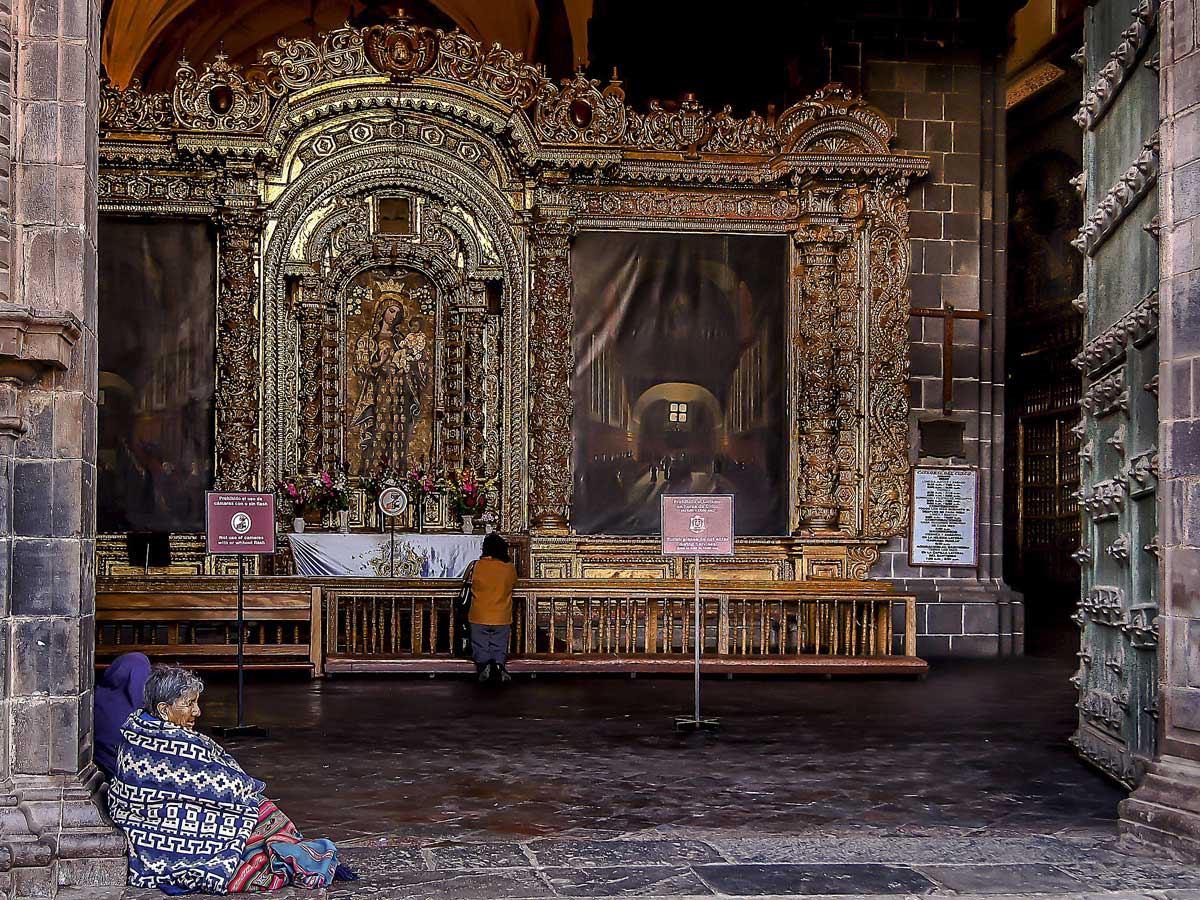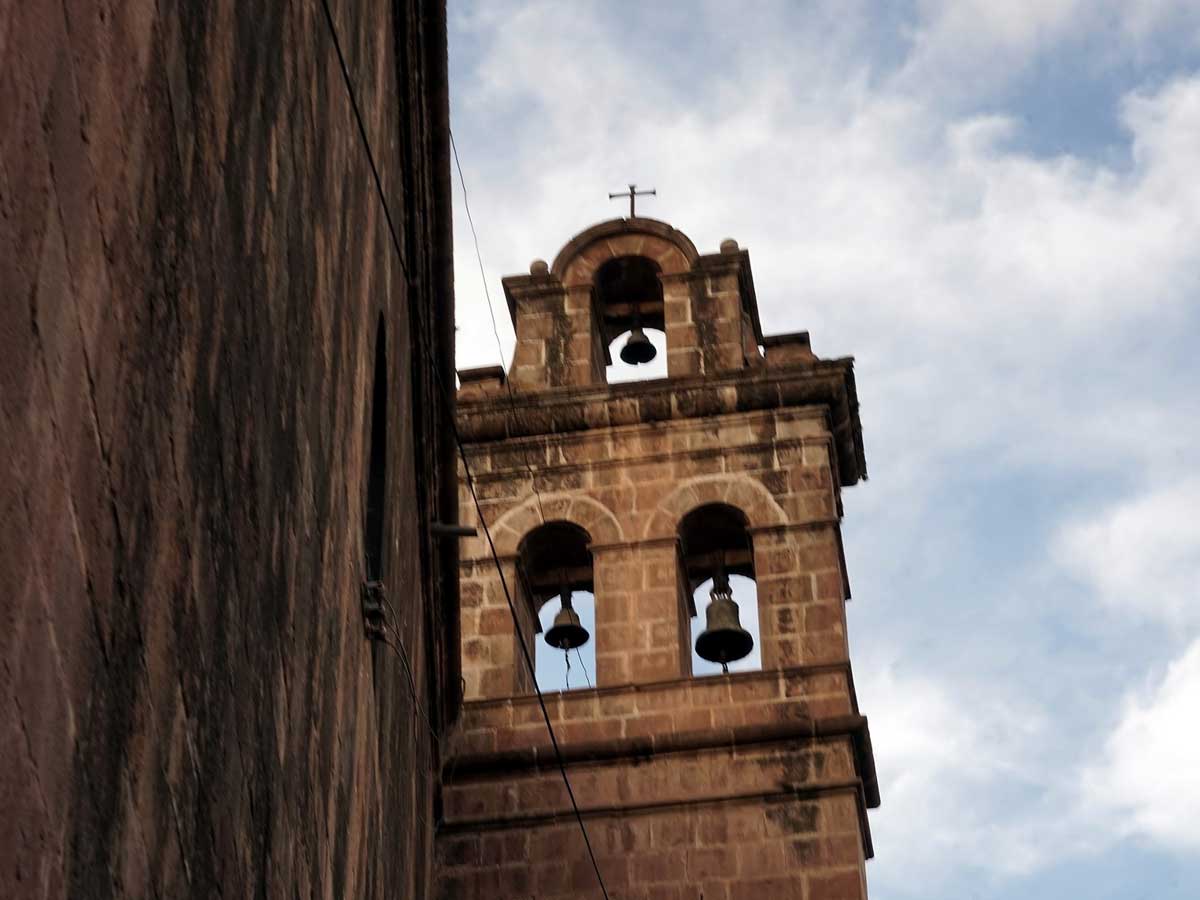

The Cathedral of Cusco is one of the most beautiful and significant monuments in America. Built between the years 1560 and 1664 on the Quishuarqancha, the ancient palace of the Inca Huiracocha, with huge blocks of stones brought from Sacsayhuaman, this historical piece is also considered a Cultural Heritage of the Nation and brings together a combination of unique characteristics such as its Gothic, Baroque style and Renaissance.
When the Spanish arrived in the city, they requested the creation of the Bishopric of Cuzco by Fray Vicente Valverde, it is for this reason that the churches in the city began to be built. However, the construction of the cathedral took more than 100 years due to the locations they had to position it. First, it would rise on the site that today occupies the Church of Triumph, then in the Cusipata area due to its size, to finally acquire the Quishuarqancha land in 1553.
The Cathedral of Cusco is located on the north side of the Plaza de Armas, in the historic center of the city.
The Cusco Cathedral, considered one of the most important works of colonial art in Peru, was built over more than a century, on top of old Inca palaces and amid the great historical changes that marked the city.
Before the arrival of the Spanish, in the place where the cathedral stands today was the Kiswarkancha palace, the residence of the Inca Wiraqocha, eighth ruler of the Tahuantinsuyo. Next to it was the Suntur Wasi, the city's armory.
With the conquest of Cusco in 1533, the idea arose to build a Christian temple that would symbolize Catholic power and faith in the new lands.

On September 4, 1538, the writ of erection was issued for the future cathedral. After discarding several places, in 1552 the old palace of Wiraqocha (Kiswarkancha), owned by Juan Solano, was bought to start the work.
The official construction began in 1560 under the direction of Juan Veramendi, who was succeeded by architects such as:
The great earthquake of 1650 seriously damaged the vault and forced a modification of the facade, removing the third body of the towers. This gave the temple a more solid and resistant look.
Finally, the cathedral was completed in 1654 by Miguel Gutiérrez de Sacio. The inaugural mass was celebrated on August 15 of that year, while the official consecration occurred on August 19, 1668, presided over by Bishop Bernardo de Isaguirre Reyes.

The Cusco Cathedral has a rectangular floor plan and a basilical style, with three main naves: the epistle nave, the gospel nave, and the central one. These match the three doors on the facade that give access to the temple. Inside, fourteen cruciform pillars stand out, which support and define the layout of the twenty-four vaults and the transept dome, giving it a monumental and harmonious look.
The Main Altar, made entirely of silver, is one of the most impressive elements, a symbol of the artistic and religious richness of the colonial period. The Sacristy holds a valuable collection of forty canvases that portray Cusco bishops and archbishops, becoming a true pictorial archive of the city's ecclesiastical history. Next to the main nave stand two annex chapels: the Church of Triumph, located to the right, and the Church of the Holy Family, to the left.
The interior of the Cathedral of Cusco is composed of innumerable works of art of all kinds that we have classified in the following way to be able to describe them.
There are the cathedral, chapels, or prisons that are part of the cathedral of Cusco and that keep invaluable pictorial and sculptural treasures, each one of them was the privilege of families or powerful groups of the city who worshiped different saints and virgins of the order. Catholic, among them, is:
The sacristy is lined with the paintings of the different Bishops who have run the Archbishopric of Cusco, starting from Bishop Valverde to the last them. In addition, a Mannerist painting of the Christ of the Agony stands out.

Behind a prominent carved wooden door are the most important treasures of the city's cathedral, including 18-karat gold pieces encrusted with precious stones belonging to various saints and virgins.
The choir of the cathedral is built entirely in cedarwood, maintaining a Baroque style that is confused with the neo-classical, in which the images of 42 church saints and 38 saints have been carved, in addition to 24 lower seats and another forty higher seats.
The main altar of the Cathedral of Cusco is probably the most important colonial goldsmith work in America, in which more than 1,250 kilos of silver were used in an altar with two bodies and three streets in whose tabernacle the rich custody of the cathedral, while the central part is occupied by a beautiful figure of the Virgin of the Immaculate Conception.
In the silverware room, rich pieces of jewelry are kept, among which are the silver canopy made in 1733 made with the legacy of Dean Francisco de Goyzueta Maldonado, in addition to the silver litters of the lord of the tremors and also those of the immaculate conception called the beautiful of the cathedral.
There are around 300 paintings of different sizes that adorn this enclosure, which come from the hand of different artists, European, indigenous, and mestizo, among them they stand out.
The apotheosis of Saint Christopher painted by Basilio Santa Cruz represents a muscular Saint Christopher who, supported by a palm tree, carries the baby Jesus on his shoulders, is located on the gate that connects the cathedral with the Church of Triumph.
Another group of important works found on the columns shows a beautiful incomplete collection of the parables of Christ painted by Diego Quispe Tito.
The famous Last Supper of the Cathedral of Cusco of Marcos Zapaca or Zapata shows a classic scene of religious painting but that has very interesting peculiarities, for example, is it a guinea pig is served as the main dish and in addition to that in the windows outside of the room in which the main characters are reproduced the surrounding mountains of the city of Cusco.
One of the most beautiful paintings of the Cathedral comes from the European brush, due to the wide use of the techniques used, this painting is attributed to Bernardo Bitti, an Italian painter from the school of Michelangelo himself.
The lord of the tremors is the most important image of the city, a religious icon that also pools in the cathedral of Cusco, this is a sculpture that represents a gigantic black Christ that has had participation throughout the centuries in the various earthquakes that the city has suffered in the years 1650, 1740 and 1950, which is why it has earned the title that it carries today, in addition to that it has been taken in procession during plagues that ravaged the capital of the Incas.
This solemn anonymous artistic work is in the nave of the Gospel, exactly next to the door that gives access to the Church of Triumph.
Below the main altar, you will find a small arched crypt. It contains the ashes of many deceased Cusco archbishops. It should be noted that in the church of El Triunfo the crypt where the remains of the chronicler Inca Garcilaso de la Vega (author of ‘The Royal Commentaries of the Incas’) rest. The crypt has a portion of the ashes of the Cusco writer. The other half is in Spain.
This section of the church is also known as 'The silver room'. It is a small side chapel that contains a varied collection of religious objects made of precious stones, gold, and, above all, silver. Among these objects, you will find an embossed silver coffin used to carry the statue of the ‘Lord of tremors’. Another element is a large trellis used during the famous 'Corpus Christi' celebration that weighs up to 160 kilos.
Hours of operation: Monday to Sunday from 10:00 a.m. to 6:00 p.m.
Cost: Entrance with the Religious Circuit Ticket, or only to this monument with the following amounts.
Partial adult: S /. 25.00
Partial Student: S /. 12.50

This ticket, which costs 40 Nuevos soles, allows you to enter, not just the cathedral, but also other religious sites of interest such as the church of San Blas and the museum of the Archbishop.
On the other hand, it is also possible to buy an independent ticket that costs 25 Nuevos soles.
Once you have this ticket, you can visit by yourself or take the services of a travel agency that offers the classic City tour service, visiting attractions such as Coricancha, Sacsayhuaman, Tambomachay, Qenqo, Pukapukara and Tambomachay in one afternoon.
a) How long did the construction of the Cathedral take?
The construction of the main architecture began in 1560 and ended in 1654, after almost a century of work, interrupted by the 1650 earthquake (which affected the ribbed vault).
b) Where to buy the ticket?
The entrance ticket can be purchased at the entrance door of the Cathedral. You can also buy the Cusco Religious Circuit Ticket, which includes a visit to the Cathedral as well as the Temple of San Blas, the Temple of San Cristóbal, and the Archbishop's Museum. In this last temple, you can buy a ticket.
c) Can I enter for free?
Yes. One way to visit the church for free is to enter during Mass, which takes place on Saturdays and Sundays at 7 in the morning and 7 at night.
d) How to get a tour guide?
At the entrance door, some people offer their services as official tourist guides, in exchange for payment. A more practical way is to book a ‘Cusco City Tour’ which includes a visit to the Cathedral as well as the tour guide service.
e) On what special date to visit the Cathedral?
Corpus Christi is the most important religious festival in Cusco. The 15 main sculptures of saints and virgins in the city are carried in procession to the Cathedral amid music, dances, and typical dishes. It is celebrated every year, on the Thursday following the day of the Holy Trinity (June).
f) Can I visit the Cathedral with a ‘City tour’?
Yes. The Cathedral of Cusco is included in the ‘City tour’, which also offers a visit to the Coricancha, Sacsayhuaman, Qenqo, Puca Pucara, and Tambomachay. All services offer tickets, transportation, and a tour guide.
g) What other churches to visit in Cusco?
The city of Cusco has dozens of colonial temples full of history and treasures. In addition to the Cathedral, tourists can visit the church of the Society of Jesus, the church and convent of Santo Domingo, the church and convent of La Merced, the church and convent of San Francisco, and others. You can buy entrance tickets at the door of the churches.
Beyond the majesty of Machu Picchu, the surroundings of Cusco offer a variety of experiences that allow you to connect with the culture, history, and landscapes of the Andean Peru. From traditional towns to little-explored natural wonders, there is much to discover just a few kilometers from the imperial city. Discover the best tours in the Cusco region:
Sacred Valley, Machu Picchu and more